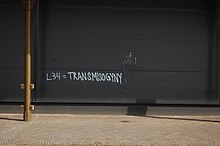
Back رهاب المتحولات جنسيا Arabic Tresmisoxinia AST Transmisogínia Catalan Transmisogynie Czech Transmisogynie German Transmisoginia Spanish Transmisogynie French טרנסמיזוגניה HE Transmisoginia Italian 트랜스여성혐오 Korean

| Part of a series on |
| Transgender topics |
|---|
|
|
| Part of a series on |
| Discrimination |
|---|
 |
Transmisogyny, otherwise known as trans-misogyny and transphobic misogyny, is the intersection of transphobia and misogyny as experienced by trans women and transfeminine people.[1][2] The term was coined by Julia Serano in her 2007 book Whipping Girl to describe a particular form of oppression experienced by trans women.[3][4][5] In an interview with The New York Times, Serano explores the roots of transmisogyny as a critique of feminine gender expressions which are "ridiculed in comparison to masculine interests and gender expression."[6]
Transmisogyny is a central concept in transfeminism and is commonly referenced in intersectional feminist theory. In her definition of transmisogyny, Serano does not limit those affected by transmisogyny to individuals who identify as transgender and includes others, such as cisgender people, and those who identify as drag queens.[7]
- ^ Kevin L. Nadal (2017). The SAGE Encyclopedia of Psychology and Gender. SAGE Publications. pp. 1728–1731. ISBN 978-1-5063-5324-1. Archived from the original on 4 June 2021. Retrieved 22 January 2020.
- ^ Arayasirikul, Sean; Wilson, Erin C. (24 August 2019). "Spilling the T on Trans-Misogyny and Microaggressions: An Intersectional Oppression and Social Process Among Trans Women". Journal of Homosexuality. 66 (10): 1415–1438. doi:10.1080/00918369.2018.1542203. PMID 30475682. S2CID 53729580.
- ^ Krell, Elías Cosenza (2017). "Is Transmisogyny Killing Trans Women of Color?". TSQ: Transgender Studies Quarterly. 4 (2): 226–242. doi:10.1215/23289252-3815033.
- ^ Serano, Julia. "Transmisogyny primer" (PDF). Archived (PDF) from the original on 26 April 2019. Retrieved 10 September 2014.
- ^ Harrison, Kelby (2013). Sexual deceit: the ethics of passing. Lexington Books. p. 12. ISBN 978-0-7391-7706-8. Archived from the original on 25 January 2020. Retrieved 4 November 2016.
- ^ Carstensen, Caitlyn (22 June 2017). "Julia Serano, Transfeminist Thinker, Talks Transmisogyny". The New York Times.
- ^ Serano, Julia (2016). Outspoken: A Decade of Transgendered Activism and Trans Feminism. Switch Hitter Press. pp. 66–79.